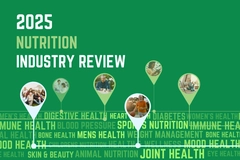
- Industry news
Industry news
Trending now
- Category news
- Reports
Trending now
- Key trends
Trending now
- Multimedia
Multimedia
Trending now
- Journal
- Events
Trending now
- Suppliers
Suppliers
Trending now
- Home
- Industry news
Industry news
Trending now
- Category news
- Reports
Trending now
- Key trends
Trending now
- Multimedia
Multimedia
Trending now
- Events
Trending now
- Suppliers
Suppliers
Trending now
SPECIAL REPORT: Freshening-Up the Frozen Food Industry
08 Mar 2016

08 Mar 2016 --- As March is National Frozen Food Month in the US, NutritionInsight explores the latest developments in one of the oldest and most widely used methods of food preservation, and its place in the 21st century grocery market.
Freezing is generally regarded as superior to canning and dehydration, with respect to preservation of taste, texture, and nutritional value. The process is a combination of the beneficial effects of low temperatures at which microorganisms cannot grow, cellular metabolic reactions are delayed, and chemical reactions are reduced.
The safety and nutritional quality of frozen products are emphasized when high quality raw materials are used, good manufacturing practices are employed in the preservation process, and the products are kept in accordance with specified temperatures.
Freezing reduces the need for additives and preservatives in food. Innovative packaging guarantees that products are easy to manage and store, therefore any unused products can be easily placed back in the freezer and used later.
Fresh vs frozen
The debate on whether fresh foods are healthier than their frozen counterparts is well known. However, in the past few years, many misconceptions around frozen food have been challenged; with independent research helping to highlight the advantages of frozen - promoting its nutritional, cost, quality and sustainability benefits.
The debate on whether fresh foods are healthier than their frozen counterparts is well known. However, in the past few years, many misconceptions around frozen food have been challenged; with independent research helping to highlight the advantages of frozen - promoting its nutritional, cost, quality and sustainability benefits.
Vitamin content is often higher in commercially manufactured produce because the moment a vegetable is picked, or a food is cooked, changes start to take place. Many nutrients begin to break down and are lost over time - freezing slows these changes down dramatically. Therefore, the shorter the length of time before freezing, the greater the retention of vitamins. For example, garden peas lose between 10% and 20% of their vitamin C content within a day of picking. Peas are commercially frozen within 3 hours of harvesting and they will be frozen at their optimal nutritional value.
The US Frozen Food Foundation promoting scientific research as well as the nutritional value of frozen foods. In 2013, they partnered with the University of Georgia to conduct a study comparing the nutrient content of eight commonly purchased frozen and fruits and vegetables.
“Our research shows that frozen fruits and vegetables are nutritionally equal to – and in some cases better than – their fresh counterparts,” said University of Georgia Associate Professor Dr Ronald Pegg, who led the study. “Vitamin A was greater in frozen produce than fresh-stored items.”
At the same time two British teams, one from Leatherhead Food Research and another from the University of Chester, carried out 40 tests to measure nutrient levels in produce which had been sitting in a fridge for three days versus the frozen equivalent. Findings demonstrated that eating newly picked produce is the healthiest option, however frozen can be almost as good and is often better that items sold as ‘fresh’ as higher vitamins and antioxidants were found in everything from frozen broccoli florets and carrots to blueberries.
Consumers
Adrienne M. Seiling, Vice President of Communications, American Frozen Food Institute (AFFI) summed up the frozen food consumers in the US to NutritionInsight: “For millions of Americans, frozen foods provide convenient access to nutritious and affordable food. Frozen food makers are offering innovative food options to meet evolving consumer needs and desires. Many products contain less fat, sugar and sodium. Others make use of whole wheat grains, added fiber and contain zero trans fat. In addition, the portion-controlled packaging of many frozen foods makes them clear choice for consumers seeking nutritious meals for themselves and their families.”
Adrienne M. Seiling, Vice President of Communications, American Frozen Food Institute (AFFI) summed up the frozen food consumers in the US to NutritionInsight: “For millions of Americans, frozen foods provide convenient access to nutritious and affordable food. Frozen food makers are offering innovative food options to meet evolving consumer needs and desires. Many products contain less fat, sugar and sodium. Others make use of whole wheat grains, added fiber and contain zero trans fat. In addition, the portion-controlled packaging of many frozen foods makes them clear choice for consumers seeking nutritious meals for themselves and their families.”
72 percent of Britons consume frozen meals at least three times a week, according to a new poll of consumers. The research, conducted by food delivery service Jinnapp, questioned more than 3,100 Brits and only 4% claimed never to eat frozen food – with the exception of frozen vegetables of any frozen homemade meals.
Almost 80% of those surveyed admitted that they only ever consume frozen meals on weekdays. More than half (52%) also revealed that they would prefer to eat fresher meals, but frozen meals offer them a “quick fix” when they don’t have the time to cook.
Across the UK, pizza emerged as the most popular frozen meal; consumers in one-third of all regions polled said that it was their go-to convenience option.
Jinnapp founder Mario Navarro said: “For those in full-time employment or looking after a family, it’s all too easy to forget about nutrition when you’ve had a busy day and just want something quick to eat. Cooking a meal from scratch seems less appealing than popping a frozen meal in the microwave but at what cost to our health? There are some healthy frozen meal options, but our findings seem to show that the dishes high in fat, sodium and carbohydrates are still the most popular.”
“Frozen pre-packaged meals can be great but they shouldn’t solely be depended on,” Navarro warns.
Industry developments
To help increase the number of healthy frozen options, there have been developments in different meal sectors – including breakfast.
To help increase the number of healthy frozen options, there have been developments in different meal sectors – including breakfast.

Iglo Group’s UK brand Birds Eye launched their new breakfast range – ‘Hello Morning!’ – at the end of last month. This is Birds Eye’s first entry into the breakfast category, “offering the same quality and taste as freshly-baked goods.”
Birds Eye UK Marketing Director, Steve Chantry, comments: “We know that breakfast makes up more than one in five of all meal occasions, yet frozen plays a role in only 1%. There is an opportunity for Birds Eye to drive interest in the category and disrupt the traditional and boring routine of cereal or toast. We anticipate that by the end of 2016, we will add £9million (US$12 million) to the frozen breakfast occasion.”
Future trends in technology
The frozen food industry is highly based in modern science and technology. Today, a combination of several factors influences the commercialization and usage of freezing technology. However, relative cost of other forms of foods, changes in tastes and preferences, and advances in freezing methods are some of the factors concerned with the future of freezing technology.
Future trends in technology
The frozen food industry is highly based in modern science and technology. Today, a combination of several factors influences the commercialization and usage of freezing technology. However, relative cost of other forms of foods, changes in tastes and preferences, and advances in freezing methods are some of the factors concerned with the future of freezing technology.
Growth in population and personal incomes, as well as increasing demand for food, has generated the need for commercial production of food commodities in large-scale operations. Thus, availability of proper equipment suitable for continuous processing would be valuable for freezing preservation methods. Producing the highest quality at the lowest cost possible is highly dependent on the technology being used. As a result, developments in freezing technology in recent years have mostly been characterized by the improvements in mechanical handling and process control to increase freezing rate and reduce cost.
Quick freezing or ‘flash-frozen’ techniques take products from cooked to frozen within a few minutes, ensuring that products are “fresher than fresh.”
The Cells Alive System (CAS) freezing method developed by Norio Owanda in Japan can keep milk and other items ‘fresh’ for months. Individually quick frozen (IQF) method is another method which doesn’t allow large ice crystals to form in vegetable cells. It is good for freezing seafood with a high water content.
Food grade liquid nitrogen freezing has many advantages over mechanical freezing and chilling processes, including speed, space and flexibility. It also helps food products maintain moisture (preventing weight loss from dehydration), quality, texture, color and flavor.
With developments such as these available, the frozen food industry is showing no signs of freezing solid.
by Kerina Tull
All content and features on this website are copyrighted with all rights reserved. The full details can be found in our privacy statement
Subscribe to our newsletters
By continuing to browse our site you agree to our Privacy Statement










